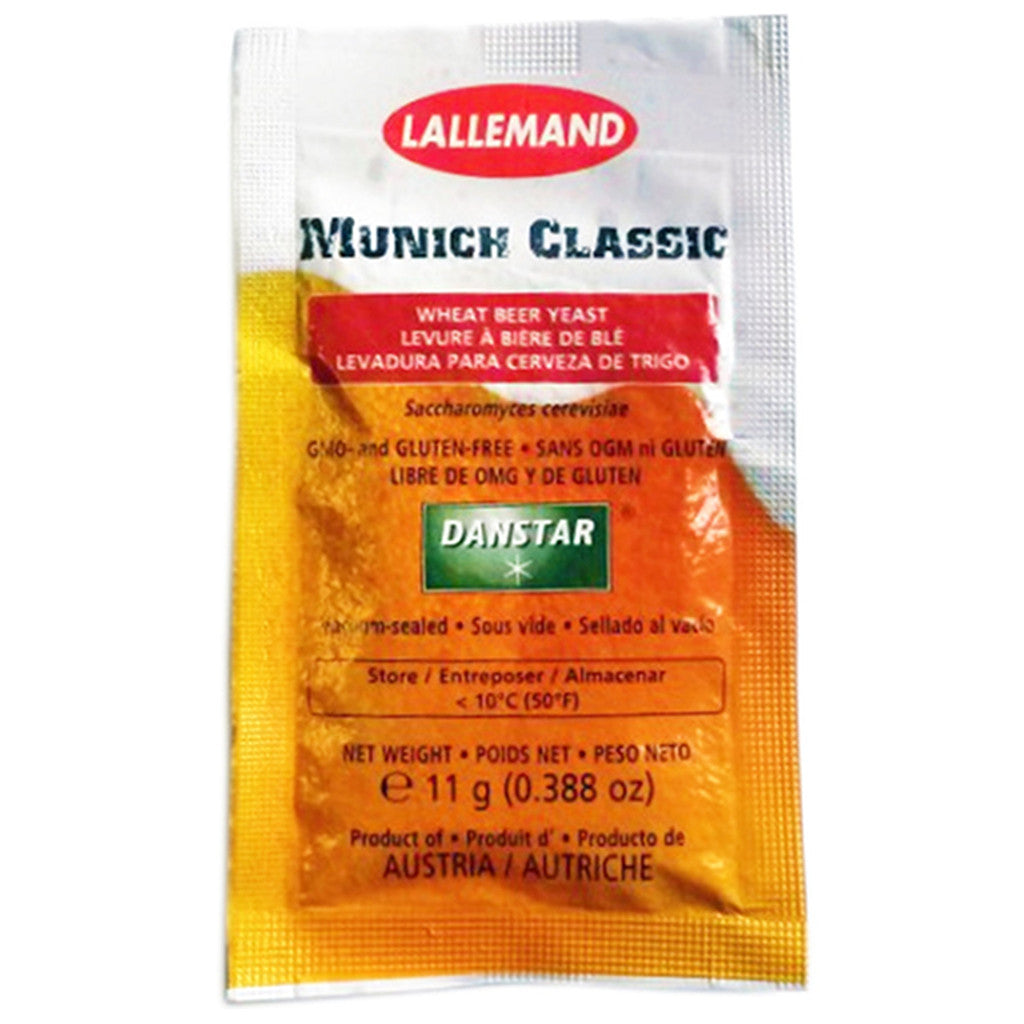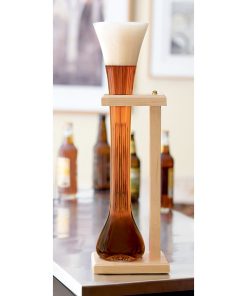Lallemand Munich Classic Wheat Beer Yeast, 11g Danstar
$ 6,09 $ 3,65
- Description
- Details
- Directions
-
Munich Classic Wheat Beer yeast is an expressive Bavarian wheat beer strain with a full spicy and estery flavor. It has a bold banana and clove character with hints of tropical fruit and red apple. It is a versatile yeast strain across a wide range of recipes and fermentation conditions. It ferments vigorously in as little as 4 days. This yeast has a medium-to-high attenuation and low flocculation. It is an authentic top-cropping yeast that can be used in open fermentations as in traditional Bavarian methods. It produces excellent Weizen, Weissbier, Dunkelweizen and Weizenbock.
-
Form: Dried Attenuation: Medium to High Flocculation: Low Ideal Temperature Range: 63º – 72ºF (17º – 22ºC) Alcohol Tolerance (ABV): 12% Net Weight: 0.39oz (11g) Download Technical Data Sheet
-
Usage:
– Use 1.9 – 3.8 grams per 1 US gallon (50 – 100g/hL) to achieve a minimum of 5 – 10 million cells/mL.
– Sprinkle the yeast on the surface of 10 times its weight of clean, sterilized (boiled) water at 30 – 35°C. Do not use wort, or distilled or reverse osmosis water, as loss of viability may result. DO NOT STIR. Leave undisturbed for 15 minutes then stir to suspend the yeast completely, and leave it for 5 more minutes at 30-35°C. Adjust the temperature to that of the wort and inoculate without delay.
– Attemperate in steps of 10°C at 5-minute intervals to the fermentation temperature by mixing aliquots of wort. Do not allow attemperation to be carried out by natural heat loss. This will take too long and could result in loss of viability or vitality.
– Temperature shock, at greater than 10°C, may cause formation of petite mutants leading to long-term or incomplete fermentation and possible formation of undesirable flavors.
– Munich Classic German Wheat Beer yeast has been conditioned to survive rehydration. The yeast contains an adequate reserve of carbohydrates and un- saturated fatty acids to achieve active growth. It is unnecessary to aerate wort.
Storage
– All active dry yeast should be stored dry below 10°C (50°F). Packaging should remain intact.
– Yeast will rapidly lose activity after exposure to air. Do not use packs that have lost vacuum.
– Open packs can be resealed under vacuum for preservation up to expiry date. Alternatively, the yeast can be placed in a plastic bag with a zipper, without air and stored in the freezer for one week or in the fridge for 3 days.
– Do not use yeast after the expiration date printed on the pack.
| Quantity | 1, 10-Pack |
|---|
Fast Shipping and Professional Packing
We have a range of shipping options thanks to our long-term partnership with UPS FedEx DHL. Our warehouse personnel will pack each item according to our strict specifications. The goods you send us are checked thoroughly and securely secured prior to shipment. Every day, we send thousands of packages to customers across many countries. This is a sign of our commitment to be the largest online retailer globally. Both Europe as well as the USA have distribution and warehouse centers.
Please note that orders with more than one item will be given a processing time according to the item.
Prior to shipment, we will examine thoroughly the items you've purchased. Most orders are shipped within 48 hours. The delivery time should be between 3-7 days.
Returns
Due to multiple entities which include the factory as well as the warehouse, we cannot fully manage stock. So the actual stock may change at any time. Be aware that it's possible that your order could run out of stock even after you've placed your order.
Our policy runs for 30 days. If you have passed 30 days without a trace since the purchase, unfortunately we can't offer an exchange or refund.
In order to be eligible for a refund, your item must be unused and in the same condition as you received it. It should also be returned in the original packaging.
Related products
Dried Ale Yeast
Liquid Malt Extract
Home Brewing Ingredient Kits (Ale)
Home Brewing Ingredient Kits (Ale)
Home Brewing Ingredient Kits (Ale)
Home Brewing Ingredient Kits (Ale)
Dried Ale Yeast
Dried Ale Yeast
Home Brewing Ingredient Kits (Ale)
Home Brewing Ingredient Kits (Ale)
Home Brewing Ingredient Kits (Ale)
Home Brewing Ingredient Kits (Ale)
Home Brewing Ingredient Kits (Ale)
Home Brewing Ingredient Kits (Ale)
Home Brewing Ingredient Kits (Ale)
Home Brewing Ingredient Kits (Ale)
Home Brewing Ingredient Kits (Ale)
Home Brewing Ingredient Kits (Ale)
Home Brewing Ingredient Kits (Ale)
Home Brewing Ingredient Kits (Ale)
Home Brewing Ingredient Kits (Ale)
Liquid Yeast
Base Malts
Dried Ale Yeast
Dried Ale Yeast
Dried Ale Yeast
Home Brewing Ingredient Kits (Ale)



































